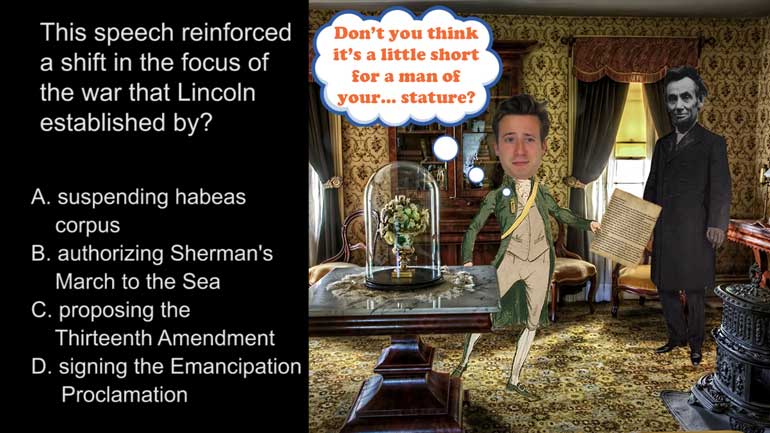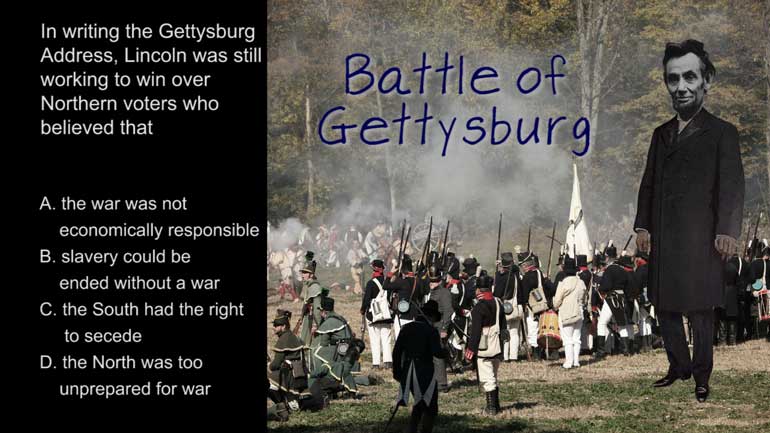ShmoopTube
Where Monty Python meets your 10th grade teacher.
Search Thousands of Shmoop Videos
AP U.S. History 1.5 Period 1: 1491–1607 303 Views
Share It!
Description:
AP U.S. History 1.5 Period 1: 1491–1607. The rhetoric expressed above in defense of enslaving American Indians most nearly matches the rhetoric employed by southern slaveholders in which of the following decades?
Transcript
- 00:00
[ musical flourish ]
- 00:03
And here's your shmoop du jour,
- 00:05
brought to you by the high road,
- 00:07
where the air is thin and your moral standing is thinner.
- 00:10
[ chuckles ]
Full Transcript
- 00:10
Check out this excerpt right here.
- 00:12
But see how...
- 00:16
[ mumbles ]
- 00:21
[ mumbling continues ]
- 00:23
Okay, lovely. And the question:
- 00:25
The rhetoric expressed above in defense of
- 00:28
enslaving American Indians most nearly matches
- 00:30
the rhetoric employed by southern slaveholders in which of the following decades?
- 00:36
And here are the potential answers.
- 00:38
[ mumbles ]
- 00:44
All right, well how can we characterize the rhetoric from the excerpt?
- 00:48
Well, the rhetoric talks a lot about the rudeness and barbarism
- 00:51
and the inherently slavish nature of the American Indians.
- 00:55
Sounds like someone woke up on the racist side
- 00:57
of the bed this morning.
- 00:58
Yeah, talkin' about you.
- 00:59
So the question wants us to figure out what time period
- 01:02
southern slaveholders were using this same argument
- 01:04
to defend their own institution of slavery.
- 01:06
Well, let's see what we got.
- 01:08
Was it in the 1750s?
- 01:10
Well, seems a bit early, right?
- 01:12
Slavery was still widely accepted in the American colonies
- 01:15
in the 18th century, even if there were pockets of dissent
- 01:18
brewing in the north. That means we can eliminate A and B.
- 01:21
Were Southerners using this kind of morally superior language
- 01:25
in the 1880s? Well, now that seems too late.
- 01:28
Remember, the 13th Amendment, which abolished slavery,
- 01:30
was adopted in 1865, so by the 1880s,
- 01:33
slavery had no place in American society.
- 01:36
So, cross D off as well.
- 01:38
And that just leaves us with C, the 1850s,
- 01:40
which sounds about right. In the early 19th century,
- 01:43
abolitionists started to protest slavery in the United States,
- 01:46
so slaveholders had to find ways to justify the existence
- 01:49
of such a horribly abusive institution.
- 01:52
Just like the excerpt, Southerners argued
- 01:54
that slaves were naturally inferior and needed protection
- 01:58
from the kind slaveholders in order to survive.
- 02:01
Well, you want some mustard on that heaping pile of, uh, baloney?
- 02:05
So, the 1850s, right before the Civil War broke out,
- 02:08
is our answer. Hard to believe those Southerners
- 02:10
made so much noise when they didn't even have a leg to stand on.
Up Next
AP U.S. History Exam 2.45. The journey shown on the map was an example of...what?
Related Videos
AP U.S. History Exam 2.26. This speech reinforced a shift in the focus of the war that Lincoln established by...what?
What did the Spanish messengers bring with them to North America? Hint: you probably wouldn't be thrilled to get this for your next birthday.
AP U.S. History Diagnostic 24. How did the United States choose containment over the National Security Council Report in Latin America?
AP U.S. History Exam 2.25. In writing the Gettysburg Address, Lincoln was still working to win over Northern voters who believed that...what?




